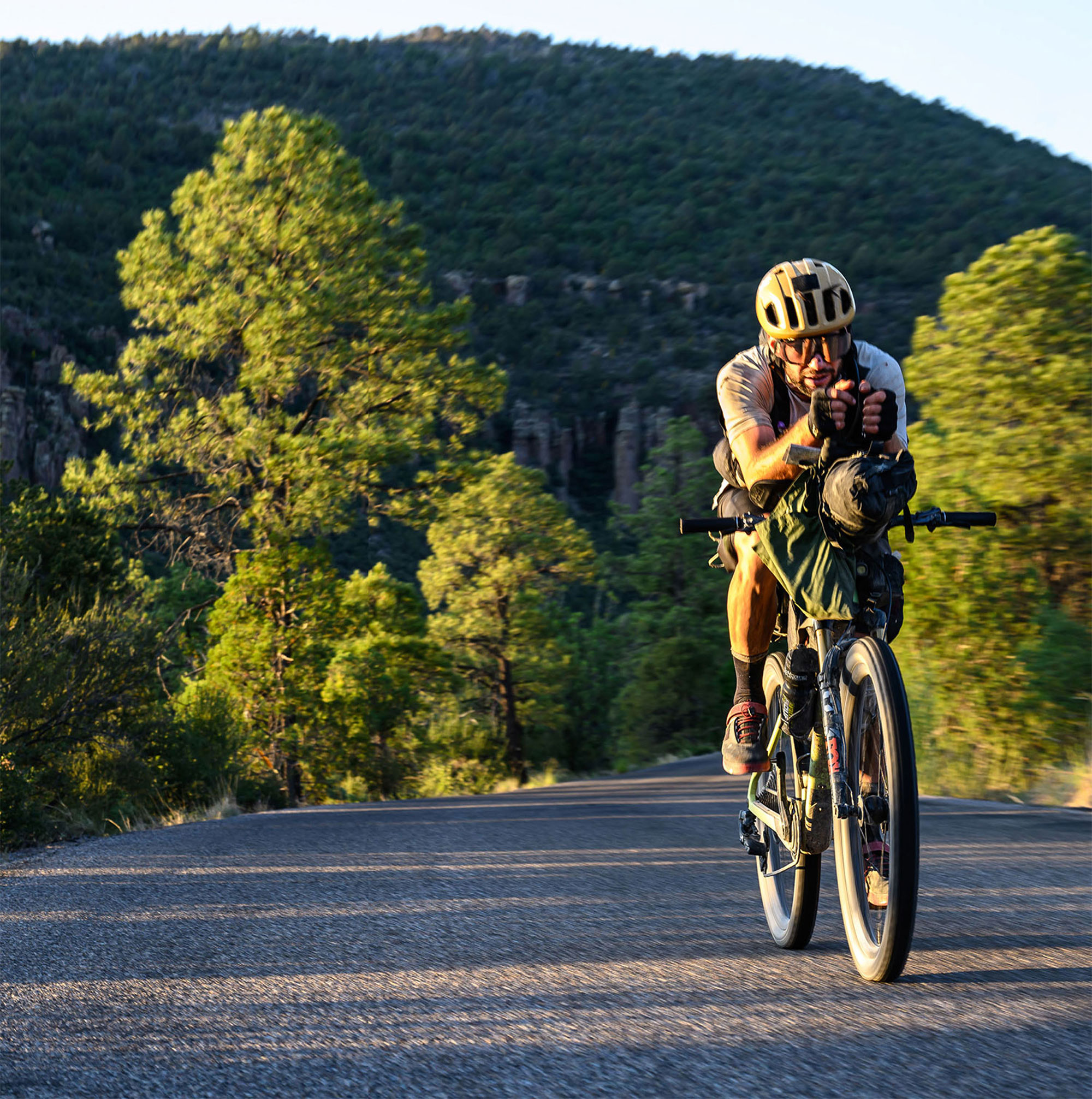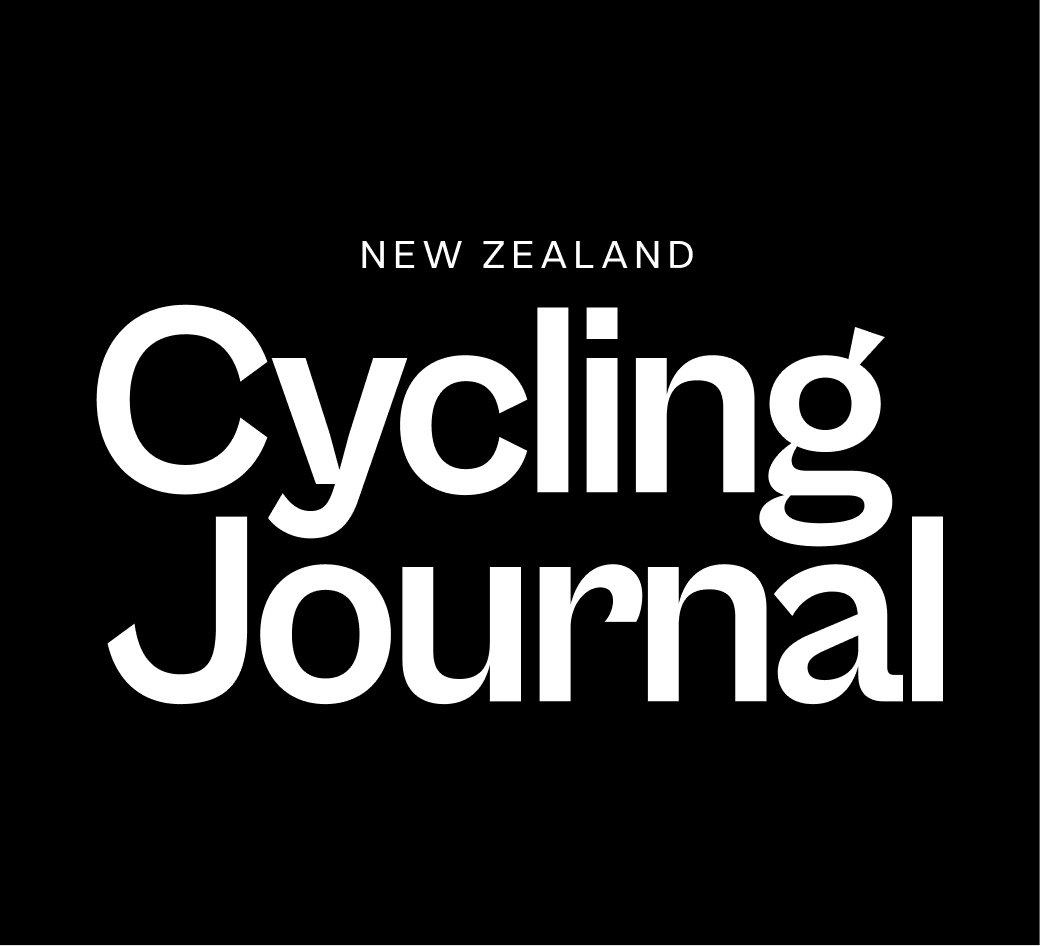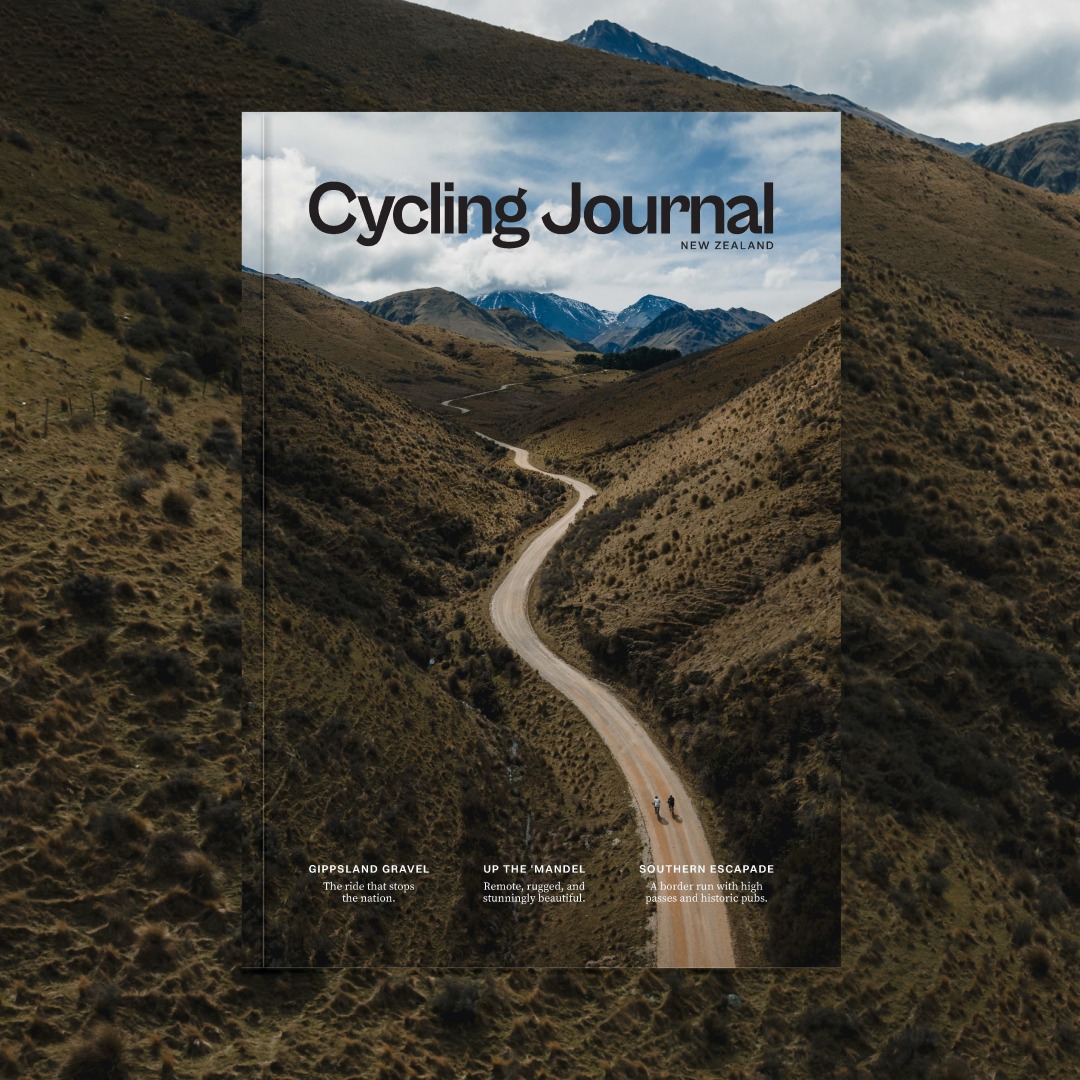Words Lester Perry
Images Eddie Clark
A MAN WAKES, DOSSED DOWN BESIDE A CISTERN IN A CAMPGROUND PIT TOILET SOMEWHERE IN THE CENTRAL USA. HE RUBS CRUSTED SWEAT AND DUST FROM HIS EYES AFTER JUST A FEW HOURS OF SLUMBER. HOW DID HE END UP HERE? NOT EVEN 12 MONTHS EARLIER, JOESEPH NATION WAS WRAPPING UP A SEASON BATTLING THE WORLD'S BEST WHILE RACING THE ENDURO EBIKE WORLD SERIES RACES, ENJOYING LIFE AS A PROFESSIONAL ATHLETE ON A FACTORY TEAM. NOW HE’S SLEEPING IN A TOILET.WHAT MISSTEPS IN A MAN'S LIFE MUST HE TAKE TO DESERVE THIS FATE?
Joe’s story starts well before his eBike racing days. Chasing the World Cup downhill dream, Joe found himself in Europe on a shoestring budget. Realising that if he wanted to spend a season riding in France, he’d need to make some sacrifices, Joe and his good mate, Rufus Wenlock, saved money on accommodation by living in a makeshift shack on the slopes of a ski field in Morzine, France. One and a half Euros a day was the food budget, not much, but enough to stay alive if you were prepared to survive solely on chocolate Brioche and frozen oven fries warmed on a camp stove. Then there’s the tale of him running out of funds before the Canadian stopover, while on his journey home from France. Unable to even afford to leave the Vancouver airport, he spent days reading books “borrowed” from the bookshop and moving his sleeping arrangements around the airport to avoid security. Eventually, he caught his flight home with not a cent to his name, but a book’s worth of memories to reflect on.
Joe’s downhill racing career spanned some six years, both nationally in NZ and abroad. Hampered by limited funds, average results (by his admission), constant bike issues and waning motivation, by 2013 Joe was looking for something fresh; Gravity Enduro racing delivered. By late 2013, Joe had well and truly caught Enduro fever, chasing events across NZ. With his downhill pedigree and motivation to train, he quickly became one to watch at home, winning or podiuming at every event he entered, through to the middle of 2014 when he returned once again to Europe – this time with a roof over his head and a more realistic food budget (although still a few bike issues). Quickly making his mark by winning the fourth round of the Specialized SRAM Enduro at Willingen, Germany, Joe was seemingly on a trajectory to the top. The emerging Enduro race format had provided the stoke he was looking for.
Leaping forward to 2022, Joe was beginning his second year on the Pole Bikes EWS E-Enduro (electric assist MTB Enduro) team, a factory- supported pro ride. The team had pivoted from riding the regular EWS World Series the prior year, now concentrating solely on the burgeoning E-Enduro series for ‘22.
The 2022 race season was one of discontent. Regardless of the hard graft that he’d put in over his off-season during training and testing, he still wasn’t performing to the level he expected of himself; on the few occasions he did, his pace just wasn’t enough to put him at the front of the field. The season came to a close and, frustrated, Joe looked for a new challenge in the off-season, hoping it would bring some freshness and renewed enthusiasm for the following race season.
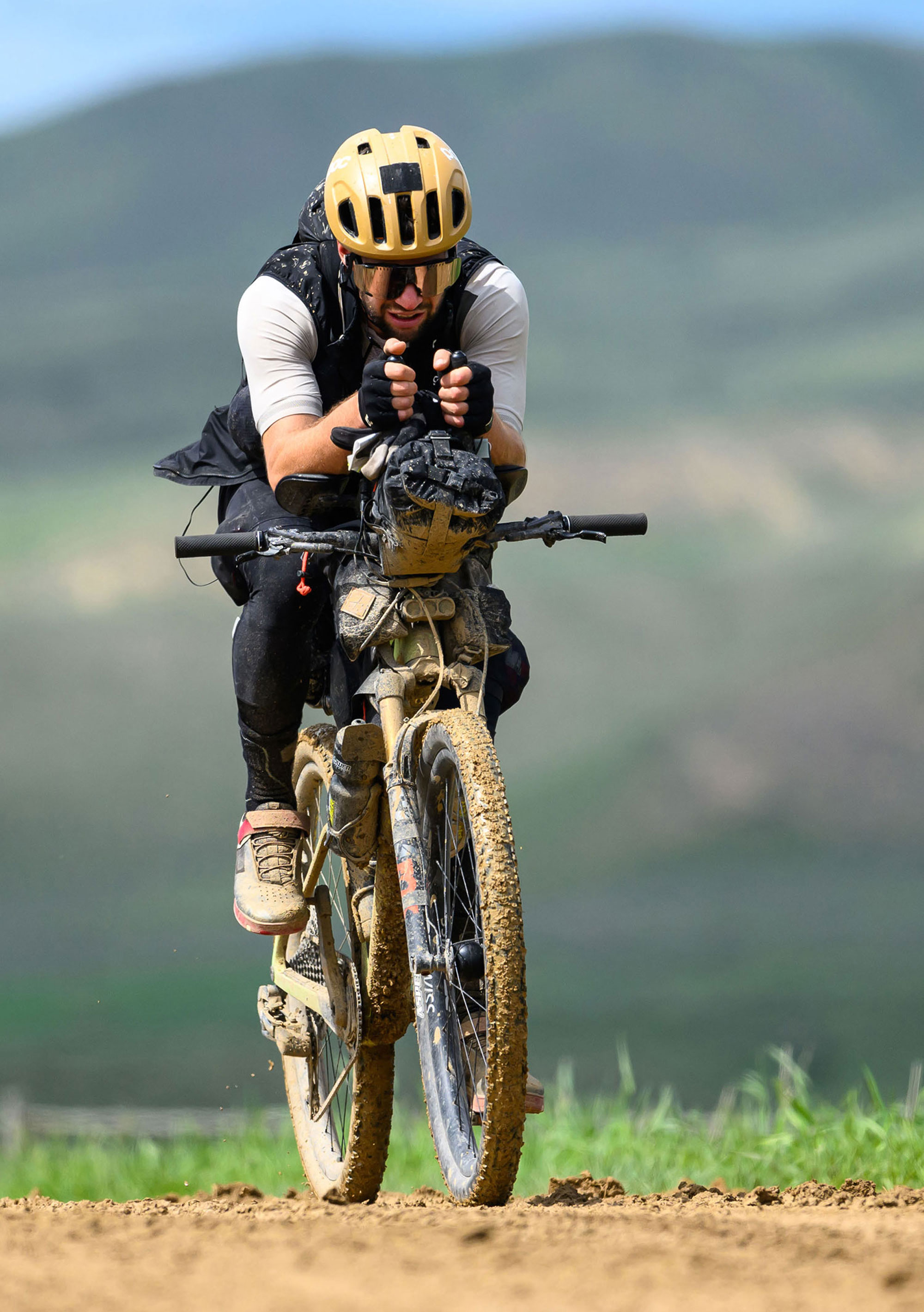
He teamed up with his friend Rufus once again; this time they weren’t chasing a downhill dream, instead they’d thrown themselves into one of Britain’s newest bikepacking Ultra events – the Great British Divide (GBD), Joe’s first taste of bikepacking Ultra racing. Some 2300km and eight days, six hours later, Joe crossed the finish line in the Nevis Range, Fort William in the Highlands of Scotland, with Rufus not too many hours behind. Athough not a race per se, they’d finished first and second. The event had planted a seed and Joe knew he wanted to take his learnings from the GBD into something even more substantial.
Returning to NZ after his northern hemisphere summer had come to a close, his spark and enthusiasm for the Enduro format had fallen as flat as his bike battery after a big day of racing. Uninspired by the format, he was now met with the harsh realisation that although he’d had some good results, he was unlikely to ever make it to the top of the podium and, even if he did – was that what he was chasing anyway?
In late 2022, his team announced another change in direction and dropped their riders for the coming year, leaving little time to find a new deal for the upcoming season. Truth be told, this was freeing for Joe and he made a quick pivot from preparing for the following season’s racing to a blank slate; searching for a fresh direction with his cycling. Remembering the buzz he had from completing the Great British Divide, he was scrolling bikepacking.com one afternoon when he stumbled upon his next big goal.
I WAS JUST SCROLLING THROUGH. I SAW THE TOUR DIVIDE, AND I WAS LIKE, OH, I'VE HEARD OF THAT. THAT MUST BE THE BIGGIE. I'LL DO THAT. LESS THAN SIX MONTHS LATER, I'M ROLLING ON DOWN THROUGH THE ANTELOPE WELLS (NEW MEXICO). IT'S BEEN A GOOD LEARNING CURVE,” EXPLAINS JOE.
The Tour Divide is a 4418km route that criss- crosses the Continental Divide from north to south starting in Banff, Canada, and finishing at the US/Mexico border in Antelope Wells, New Mexico. The route features 90% off-road riding on dirt and gravel roads, some trails, and a few short sections of unmaintained track. Every year the official ‘race’ event draws riders from around the world, keen to test themselves against not only each other but the route itself.
While prepping for the Tour Divide, Joe made himself known in the NZ bikepacking scene. Sounds to Sounds, Le Petite Brevet and the Great Southern Brevet were all on his hit list and not only did he deliver some impressive performances, he was learning valuable lessons that would come into play at every subsequent Ultra. Some riders at these events knew of Joe and his love for going fast and long, while others grumbled, wondering why he’d bother doing the events the way he preferred, as he’d miss all the scenery and much of the social aspect, too.
After dissecting the South Island from the Marlborough Sounds to Milford Sounds during the Sounds to Sounds (S2S) event, he knew a solid performance at Tour Divide was a possibility – everything just had to go as planned. S2S proved he was capable of pedalling around 300km and climbing 3500 – 4000m on mainly gravel roads, per day. Of arriving at Milford Sound having done five days of this, back-to-back, with about four hours of sleep each night, Joe says: “I thought to myself like, yeah, I’m uncomfortable, that’s for sure, but I could probably do it two more times if I needed to. So then I knew I was aiming for a 14 to 15 day ride, a competitive sort of time, on the Tour Divide.”
“I got a lot more out of those events I’d done in the 12 months leading up to TD than I expected. I had expected to get a lot out of them in terms of seeing some scenery and riding from one side of the country to the other, but I ended up learning a fair bit about myself and what I’m capable of. And yeah, the highs and lows were definitely something that I haven’t encountered in any other sport that I’ve done. So after a while, not immediately – it was quite intimidating at the start – but after a while, I was like – well, I could do more of this.”
In previous years he’d put countless hours into his preparation for races, ensuring he was at the top level physically. Even then there was frustration when things didn’t go to plan. “I liked the process that I ticked off when prepping for an EWS, all the training build-up, and making sure I’d hit the numbers I wanted to before every season. Making sure I hit the strength gains that I wanted to in the gym and then with everything put in place, I’d turn up to a season or a start line in the best shape possible. The annoying thing about Enduro is that you can do all of that and then you can just not have the speed. It’s just brutal. There’s so much more going on in those gravity sports with just your mindset and your confidence, your bike and your team, your surroundings.”
The realisation that he was a “good preparer but not such a great racer” was beginning to hit home and what had been a negative in the Enduro space, was a positive for Ultra events. “What I noticed after doing a few of these ultra- distance events is that what I was putting in, I was getting out. I could just focus on preparing. If I prepared well enough in terms of the gear, figuring out what could go wrong, what will go wrong, and how I’m going to adapt and evolve when the shit hits the fan… If you do enough of that, plus obviously be fit, it’ll pay off, you’ll get out what you put in.”
Joe applied the same dedication and science- backed training mentality he’d used during his seven years of pro-level EWS racing, transferring all that learning across to Ultra cycling. He was well prepared for the events he lined up for, irrespective of a lack of experience in Ultra racing itself. Working with his Coach, a sports scientist, he adapted his training to suit the vastly longer format, undertaking hours of Zone 2 training, and layering sessions with heavy intervals where applicable. Joe appears to take a much more focused and analytical approach than many of his competitors.
“I don’t know many of them (his competitors), but as far as I can tell, I’m way more science-y. A lot of them just ride bikes because they love it and they ride a lot of bikes, so they’re very good at it. I really like the science side of it. I’d rather just do aggressive training, which is basically as if I was training for a cross-country race and just make sure I do a fair bit of volume as well, then show up to the start line. I don’t want to just go and meander around in the hills for a full day, I certainly don’t want to go and do slow bikepacking trips. That doesn’t appeal at this point in my life.”
A typical block of training would range from 15 hours a week, up to 25, and then he peaked out with his largest pre-Tour Divide training week at 35 hours. Reflecting on his TD preparations, Joe now realises he could have done fewer hours on the bike, but more time looking after his body; incorporating more yoga, mobility and gym work, rather than just raw bike time, all helping his overall physical durability. “I don’t even know whether I need to be as fit as I was coming into the Tour Divide. I put a lot of hours into it. I was stuck on this mindset that I had to do that much training because I wanted to be one of the fittest there. Now I realize that we’re not pedalling hard at all. We’re just going for fifteen days nonstop.”
“I had issues with my quad, lots of pain. I had a lot of foot pain too. I think I’ve alleviated that now with a super wide set of shoes, but also it (less on-bike time) would have just given me a bit more time to prepare, look into the course and then just feel more comfortable with everything. When you’re doing thirty-five hours of riding a bike a week, you don’t have much energy for anything else. I was trying to juggle too much, basically trying to figure out a four- and-a-half thousand kilometre course at the same time as training and having to buy and get all the gear that I needed. It was just quite overwhelming.”
Regardless of all his methodical preparation, one minor oversight almost derailed his TD experience just hours after the start. Discovering he had no base map loaded into his Garmin, Joe was working with limited navigational info, eventually relying on his phone as a backup.
“I was unimpressed with myself for how much of an effect something like that had on me. And I think it just comes down to knowing how well I thought I prepared for it. I spent five months meticulously going over every item and just every eventuality and then I had no map on my Garmin. I didn’t really roll with the punches for that one. That should have lasted half an hour, but it didn’t. It lasted a full day, and it actually took me to have a sleep in a hotel and then wake up again to just go, oh, I was a mess, it’s sorted out, let’s just carry on.”
“I WANTED EVERYTHING TO BE PERFECT, BUT AT THE END OF THE DAY, WITH THESE EVENTS, IT'S JUST LIKE, WHO CAN ROLL WITH THE PUNCHES THE BEST? AND IT TOOK A WHOLE DAY FOR ME TO FIGURE THAT ONE OUT.”
The next day Joe woke with a fresh, positive mindset and went to work trying to limit his losses. The legs were good and, over the 400km day, he leapfrogged up from 28th in the standings to 8th. “I was proud of myself because I didn’t just get excited and go, I’m here to win. I just chipped away at it, kept an eye on my power output and my heart rate and just did what I could, but just added a couple of percent, on top. I didn’t get too excited and blow myself up. So it was a good lesson. By the end of that day, I realized just how big this race was and that it wasn’t all over. I was well and truly ‘in it’. I kept a cool head and had a good day on day two.”
Across all aspects of his preparation, and during the event, regardless of the conditions or situations he found himself in, his stout discipline helped keep things on track. Sticking to his daily hygiene practice was key to staying healthy and in good physical form. Knowing saddle sores could easily take a rider out of the event; regardless of how fatigued or saturated he was, he’d remove his bib shorts, dig out some antibacterial wipes from the depths of his bags and give himself a clean-up, then apply some cream; ensuring an infection-free ride. This was a daily routine he adhered to regardless of what position he was in.
Ultra racing has become synonymous with sleep deprivation, with some riders wearing their lack of sleep as a pseudo badge-of-honour. Not one to get carried away by the hype, knowing his body and understanding how important his recovery was, Joe planned to try and hit an average of 4 hours of sleep every 24 hours.
“I was aiming for four hours sleep but then if it was a very cold or sort of snowy, like a wet night and I was out in a bivy, I’d be like, well, this sleep is going to be average anyway, so I might as well just cut it down to three or 3.5 hours. Then, if it was one of the nights I was in a hotel or if I was in a pit toilet in the national parks, it’s always a couple of degrees warmer, you’re not getting rained on, all that stuff. So sometimes I’d even push it out to four and a half hours, if I was warm and dry.”
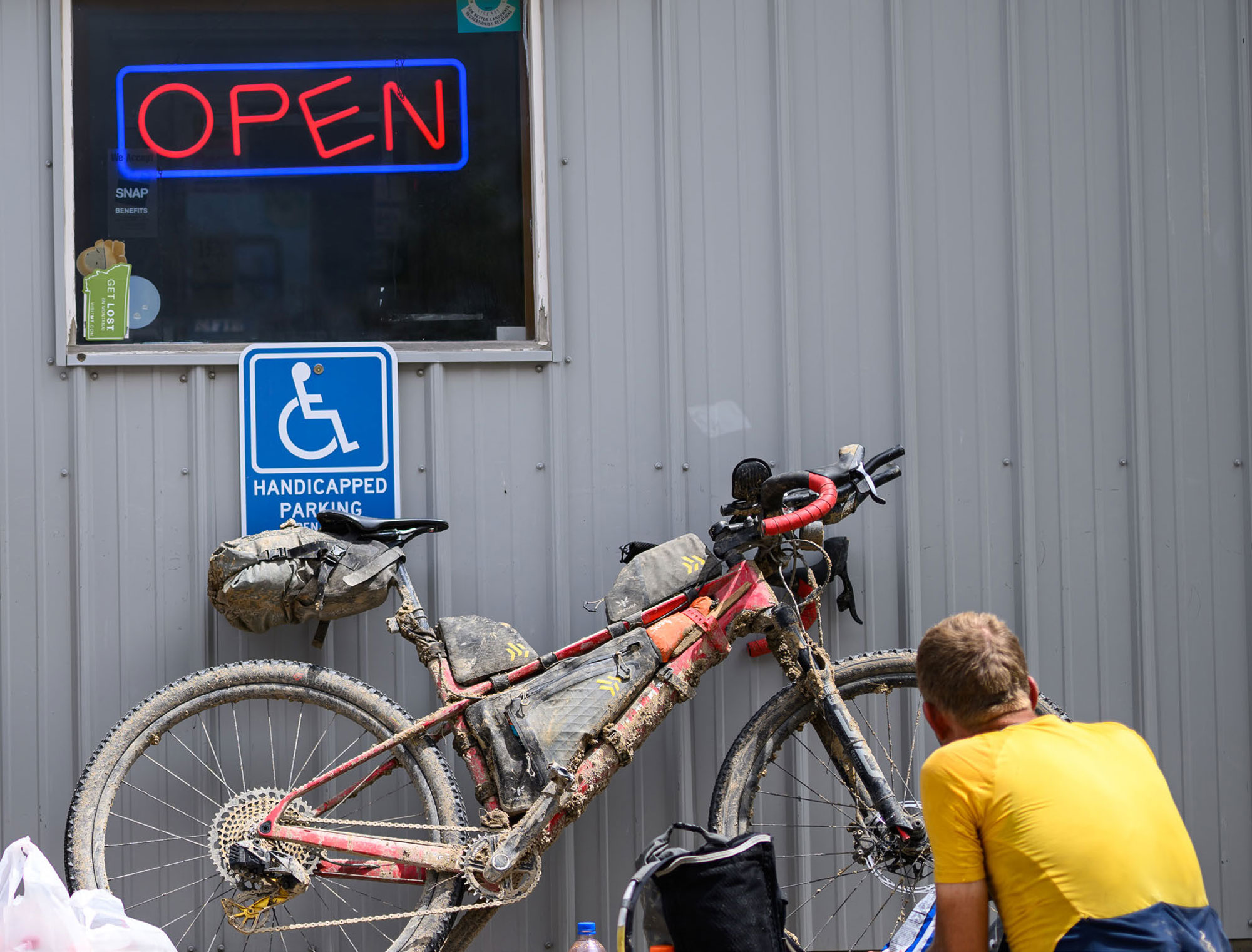
“TWO ALARMS WOULD GO OFF AFTER FOUR HOURS AND I'D JUST ASSESS THE BODY AND HOW I'D FEEL. IF THERE WAS RECEPTION, MAYBE I'D LOOK AT WHERE OTHER PEOPLE WERE, AND I MIGHT PUT MY HEAD DOWN FOR ANOTHER HALF HOUR. THAT'S SORT OF HOW I PLAYED IT.”
Knowing the finish line was drawing closer, for the final three nights Joe switched up his sleep routine, pushing hard into the dark hours, sleeping only once he was virtually falling off the bike each day. Only then did hallucinations begin to become a factor.
“It got to the point, in New Mexico, where every shadow and every tree looked like something moving and seemed like a face or something coming at me. Maybe you’d hear a few noises and maybe the roadkill would get up and start walking away or something. But I was always conscious enough to just be like, yeah, I’m very tired right now. I never got carried away to the point where I just lost my head. I was just like, I should eat more, or maybe I should start looking for a place to sleep. So I kept my head. But yeah, I was definitely seeing some things by then.”
Competing in an Ultra event draws riders into a ‘bubble’ of sorts; normal human interactions are replaced by grunts or slurred, barely decipherable sentences. Regular life continues in the small towns the event passes through, but for those immersed in their own race, they’re existing in a completely separate parallel reality.
“You walk into these stores, and you know you stink. You just can hardly speak properly to these people, and you’re just piling $100 worth of absolute trash food onto the counter. I’m usually quite a self- conscious guy, but in those moments, I just didn’t even care. They’d ask questions and sometimes I’d be blunt enough to just be like, oh, yeah, can you just hurry up? I’m not a rude person. It’s an example of how much of a mission I was on to just keep moving forward. And then you jump back on your bike, and all of a sudden you’re in the woods in the middle of nowhere, and you can take a bit of a sigh, a deep breath, like, oh, that was full on.”
Eight days in, while crossing the Great Basin of Wyoming, the course passed through 25km of sticky mud. The section should have taken around an hour and a half, instead, Joe was plugging away for four hours, battling to keep his wheels turning and chain on the chainring due to the mud buildup. Arriving in Wamsutter at 3:30 am, he picked up the 24-hour phone line outside a hotel and asked if they had any rooms. “She said, no, we’re full up. I think she could just hear that I was relatively broken. I asked, do you mind if I sleep there in the phone shelter? I was really politely asking her whether I could just sleep there. Then she came down and could see the bother I was in. I thought she’d come down to tell me to go away, but she was like, oh, we’ve got a room.” She ushered him into a room that was awaiting fumigation with instructions to not go to the far side of the room. “I just turned to her and said, you’re an angel. I don’t use that word lightly, but that’s what it meant to me. She absolutely saved the race because it was just right when I needed a bit of a roof over my head and a good couple of hours of sleep. It was a gross place, basically a giant intersection of some huge roads, so it would have been a really crap place to just bivy up. She hooked me up and it was amazing.”
Early in 2023, Joe raced the Oamaru round of the XCO MTB National Series, it was here he identified a chink in his armour and made some changes to his training. Battling with the front runners early in the race, after a few laps the heat of the day took its toll, he blew up and saw his power output fall off a cliff. “I had some good discussions with the coach about body weight and heat management after that race. I incorporated a whole bunch of sauna sessions leading into Tour Divide. I’d purposely do some of my training efforts in the heat, then throughout the course, even when I was feeling quite dehydrated, I’d still save salt tabs for New Mexico because I was just so on edge about what was going to happen in that heat, and it delivered.”
Battling near 40-degree heat through New Mexico, Joe became borderline paranoid about running out of water, stocking up with seven litres at each stop, then conserving it for as long as possible. Riding through areas of 200km of dry desert before the next fill, it began to play with his head. He was finishing stretches dehydrated, having been too conservative with his water, and began overthinking things; like being afraid of getting a mechanical and being stranded in the desert with no water. Becoming overly cautious, descending overly slowly down the hills, his time was trickling away.
“I WAS CONSTANTLY DOING CALCULATIONS IN MY HEAD OVER THE WHOLE RACE, BUT THAT WAS JUST MULTIPLIED IN NEW MEXICO AND, BEING ELEVEN DAYS IN BY THEN, THE FATIGUE WAS VERY REAL AND THE CALCULATIONS JUST INCREASED. I STARTED LOSING IT A LITTLE BIT. NEW MEXICO AS A WHOLE WAS GNARLY, AND THEN ONE SPOT IN PARTICULAR CALLED THE HEALER WILDERNESS WAS JUST BRUTAL.”
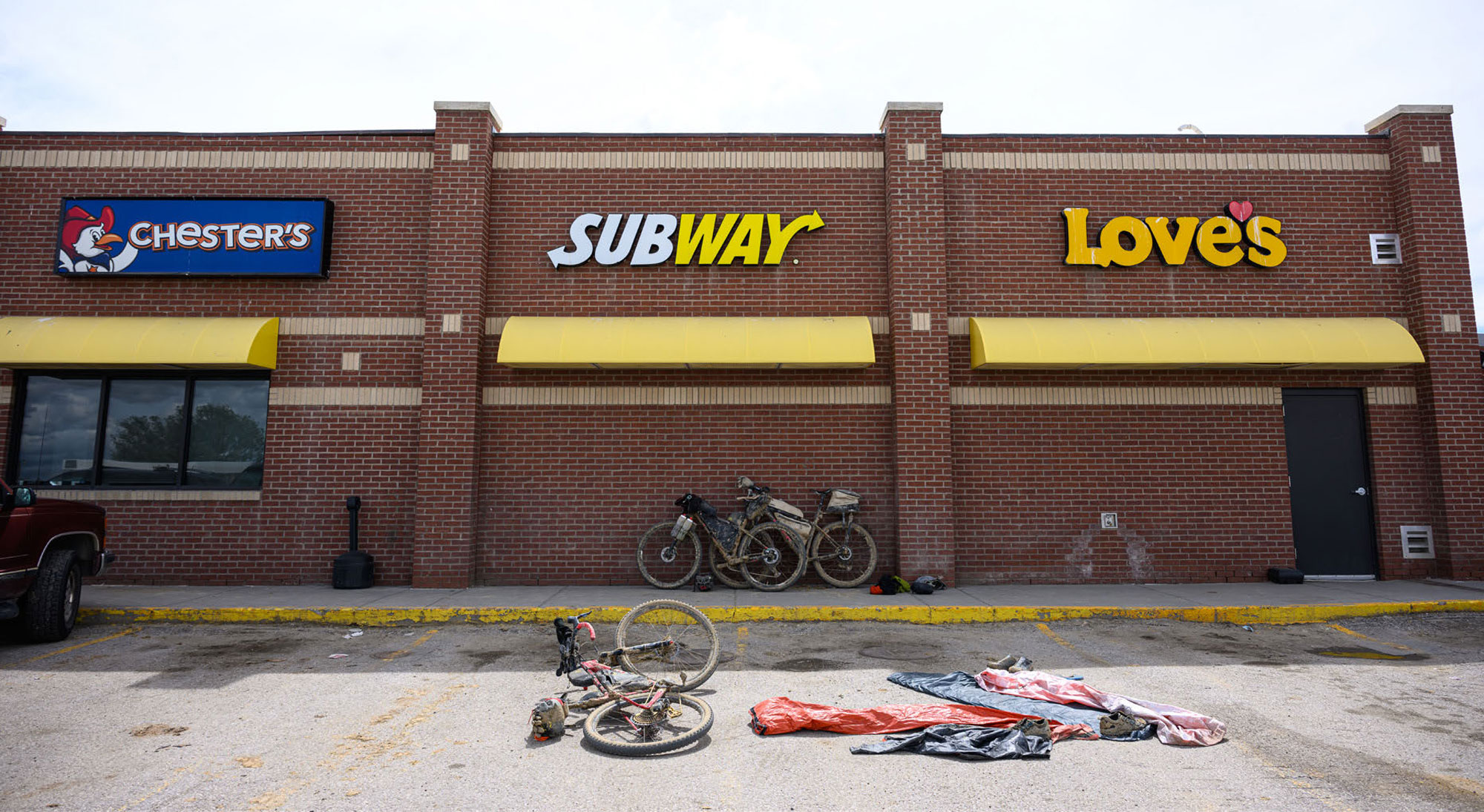
Having completed the route in 15 days, 2 hours and 50 minutes, finishing 3rd overall, and marking a major life milestone, Joe reflects on the experience as a whole: “It feels like a culmination of 30 years of experiences, coming together and just laying it down in two weeks. The further I get away from it, the more frustrated I get with the time lost, because at the time, halfway through, I was just like, I just need to finish, this is really hard, I just need to finish. And then when I got to the podium, it felt like a win. It was that hard. And those guys in the front were so fast, but now I just keep thinking back. You lose sight of all the trauma, it just erases itself over time, and now I just go, oh, why did I do this, why did I do that?”
“I LEARNED SO MUCH AND IT JUST LEAVES ME WANTING MORE. BUT, MORE THAN ANYTHING, I'M JUST EXCITED BECAUSE WITH ENDURO (MTB) RACING, I PUSHED REALLY HARD AND I WAS GOOD ENOUGH TO BE PROFESSIONAL AT IT FOR YEARS, WHICH IS A HUGE ACCOMPLISHMENT, BUT I JUST WASN’T ONE OF THE BEST IN THE WORLD. JUST HANDS DOWN. I’D JUST HAVE THESE BLINDING RACE RUNS IN MY EYES AND THEN PEOPLE WERE BEATING ME BY 15, 20 SECONDS. I WAS LIKE, FAIR PLAY. NOW I’M AT QUITE AN EXCITING TIME IN MY LIFE BECAUSE IT SEEMS LIKE IF I PIECE EVERYTHING TOGETHER RIGHT, I CAN BE ONE OF THE BEST IN THE WORLD AT THIS ULTRA STUFF.”
“In the middle of the Divide when things were getting pretty tough, I was thinking to myself a lot of people have had it so much worse than this, and I was just channelling people going to war, and people escaping countries and stuff. So whenever I was moaning about having a sore ass or hallucinating in the dusty bloody wilderness, I’d just be like, I’ve chosen to do this. It’s not even that bad. I’m riding through a beautiful place and other people are suffering a lot worse and they don’t even have a choice. That’s just what always snapped me back, to just be like, how bad can it be? This isn’t that bad. You chose to do this.”
“When people ask me why I’d want to put myself through the full-on discomfort of something like doing the Tour Divide over a couple of weeks; I just think in this day and age, discomfort is looked upon in a poor light. Why would you ever want to be uncomfortable? If you can avoid it, then avoid it. But, what I’m learning, and what a lot of people are learning, is that these Ultra events put us in situations where our bodies and our minds really thrive.”
“It’s really hard, but then you come out the other side, you get the high and you get the story, and you get a sense of achievement that in this day and age, is hard to find.”
